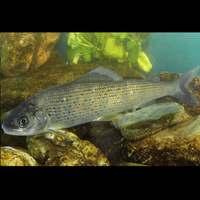Thymallus aeliani: The Adriatic Grayling.
Thymallus aeliani, known as the Adriatic grayling, is a rare and localized grayling species historically found in Lake Maggiore and its tributaries. Later research found that the Thymallus found in the Adriatic rivers from the Po River basin up to the Soča River basin are the same species. It is a genetically distinct member of the grayling complex and has suffered severe population decline in recent decades.
Taxonomy and Classification.
Belonging to the family Salmonidae and genus Thymallus, Thymallus aeliani was originally described by Valenciennes in 1848. Its taxonomic status was long debated, but recent molecular and morphological research has led to the revival of the species name with the designation of a neotype. It is now recognized as one of at least three valid Thymallus species in Europe: the widespread Thymallus thymallus (European grayling), Thymallus ligericus (Loire grayling), and Thymallus aeliani (Adriatic grayling).
Physical Characteristics.
The Adriatic grayling resembles other European graylings but may be distinguished by:
- Smaller body size
- Subtler coloration and less prominent dorsal fin patterning
- it has a bluish tinge in its fins and tail (compared to the reddish tail of T. thymallus)
- Unique mitochondrial DNA sequences
- Light brown to silver body coloration with fine spotting
Adults typically reach 20–35 cm in length, though older individuals may exceed 50 cm. Rapid growth occurs during the first year of life.
Habitat and Distribution.
Thymallus aeliani is native to the River Basins from the Po in the west up to the Soča in the east and the Lake Maggiore region, spanning parts of northern Italy and southern Switzerland. It was once widespread in the Ticino River and nearby water bodies, preferring cool, well-oxygenated waters with gravel beds. Currently pure populations are only found in the Po River basin. In other parts of it's native range only hybrid fish can be found due to stocking of Thymallus thymallus.
Ecology and Life History.
Adriatic grayling spawn in April and May, migrating into small tributaries where they deposit their eggs in gravel. Juveniles typically remain in calmer, shallower areas before moving into deeper or faster water. Their diet includes aquatic insects, crustaceans, small fish, and plant material. They play a role as both predator and prey in their native ecosystems.
Conservation Status and Threats.
Thymallus aeliani is considered critically endangered or possibly extinct in the wild. Key threats include:
- Habitat destruction and river regulation
- Pollution and eutrophication
- Genetic dilution from stocking of non-native grayling
Efforts to locate surviving individuals and protect remnant habitats are ongoing but face significant challenges.
Cultural and Scientific Significance.
As one of the most genetically distinct grayling species in Europe, Thymallus aeliani holds substantial scientific value for understanding freshwater speciation and conservation genetics. Its decline serves as a cautionary tale about the consequences of unmanaged fish stocking and habitat alteration.

